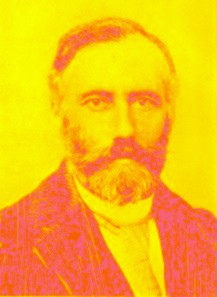

____________
THE
OF
THEOSOPHY

A Definitive Work on Theosophy
By
William Quan Judge

CHAPTER 12
Kama Loka
Let us now consider the states of man after the death of the body and
before birth, having looked over the whole field of the evolution of things and
beings in a general way. This brings up at once the questions: Is there any
heaven or hell, and what are they? Are they states or places? Is there a spot
in space
where they may be found and to which we go or from where we come? We
must also go back to the subject of the fourth principle of the constitution of
man, that called Kama in Sanskrit and desire or passion in English. Bearing in
mind what was said about that principle, and also the teaching in respect to
the astral body and the Astral Light, it will be easier to understand what is
taught about the two states ante and post mortem. In chronological order we go
into kama loka -- or the plane of desire -- first on the demise of the body,
and then the higher principles, the real man, fall into the state of Devachan.
After dealing with kama loka it will be more easy to study the question
of Devachan. The breath leaves the body and we say the man is dead, but that is
only the beginning of death; it proceeds on other planes. When the frame is
cold and eyes closed, all the forces of the body and mind rush through the
brain, and by a series of pictures the whole life just ended is imprinted
indelibly on the inner man not only in a general outline but down to the
smallest detail of even the most minute and fleeting impression. At this
moment, though every indication leads the physician to pronounce for death and
though to all intents and purposes the person is dead to this life, the real
man is busy in the brain, and not until his work there is ended is the person
gone. When this solemn work is over the astral body detaches itself from the
physical, and, life energy having departed, the remaining five principles are
in the plane of kama loka.
The natural separation of the principles brought about by death divides
the total man into three parts:
First, the visible body with all its elements left to further
disintegration on the earth plane, where all that it is composed of is in time
resolved into the different physical departments of nature.
Second, the kama rupa made up of the astral body and the passions and
desires, which also begins at once to go to pieces on the astral plane;
Third, the real man, the upper triad of Atma-Buddhi-Manas, deathless but
now out of earth conditions, devoid of body, begins in devachan to function
solely as mind clothed in a very ethereal vesture which it will shake off when
the time comes for it to return to earth.
Kama loka -- or the place of desire -- is the astral region penetrating
and surrounding the earth. As a place it is on and in and about the earth. Its
extent is to a measurable distance from the earth, but the ordinary laws
obtaining here do not obtain there, and entities therein are not under the same
conditions as to space and time as we are. As a state it is metaphysical,
though that metaphysic relates to the astral plane. It is called the plane of desire
because it relates to the fourth principle, and in it the ruling force is
desire devoid of and divorced from intelligence.
It is an astral sphere intermediate between earthly and heavenly life.
Beyond any doubt it is the origin of the Christian theory of purgatory, where
the soul undergoes penance for evil done and from which it can be released by
prayer and other ceremonies or offerings.
The fact underlying this superstition is that the soul may be detained
in kama loka by the enormous force of some unsatisfied desire, and cannot get
rid of the astral and kamic clothing until that desire is satisfied by some one
on earth or by the soul itself. But if the person was pure minded and of high
aspirations,
the separation of the principles on that plane is soon completed,
permitting the higher triad to go into Devachan. Being the purely astral
sphere, it partakes of the nature of the astral matter which is essentially
earthly and devilish, and in it all the forces work undirected by soul or
conscience. It is the slag-pit, as it were, of the great furnace of life, where
nature provides for the sloughing off of elements which have no place in
Devachan, and for that reason it must have many degrees, every one of which was
noted by the ancients.
These degrees are known in Sanskrit as lokas or places in a metaphysical
sense. Human life is very varied as to character and other potentialities, and
for each of these the appropriate place after death is provided, thus making
kama loka an
infinitely varied sphere. In life some of the differences among men are
modified and some inhibited by a similarity of body and heredity, but in kama
loka all the hidden desires and passions are let loose in consequence of the
absence of body, and for that reason the state is vastly more diversified than
the life plane. Not only is it necessary to provide for the natural varieties
and
differences, but also for those caused by the manner of death, about
which something shall be said. And all these various divisions are but the
natural result of the life thoughts and last thoughts of the persons who die on
earth. It is beyond the scope of this work to go into a description of all
these degrees, inasmuch as volumes would be needed to describe them, and then
but few would understand.
To deal with kama loka compels us to deal also with the fourth principle
in the classification of man's constitution, and arouses a conflict with modern
ideas and education on the subject of the desires and passions. It is generally
supposed that the desires and passions are inherent tendencies in the
individual, and they have an altogether unreal and misty appearance for the
ordinary student. But in this system of philosophy they are not merely inherent
in the individual nor are they due to the body per se. While the man is living
in the world the desires and passions -- the principle kama -- have no separate
life apart from the astral and inner man, being, so to say, diffused throughout
his being. But as they coalesce with the astral body after death and thus form
an entity with its own term of life, though without soul, very important
questions arise.
During mortal life the desires and passions are guided by the mind and
soul; after death they work without guidance from the former master; while we
live we are responsible for them and their effects, and when we have left this
life we are still responsible, although they go on working and making effects
on others while they last as the sort of entity I have described, and without
our direct guidance. In this is seen the continuance of responsibility.
They are a portion of the skandhas -- well known in eastern philosophy
-- which are the aggregates that make up the man. The body includes one set of
the skandhas, the astral man another, the kama principle is another set, and
still others pertain to other parts. In kama are the really active and
important ones which control rebirths and lead to all the varieties of life and
circumstance upon each rebirth.
They are being made from day to day under the law that every thought
combines instantly with one of the elemental forces of nature, becoming to that
extent an entity which will endure in accordance with the strength of the
thought as it leaves the brain, and all of these are inseparably connected with
the being who evolved them. There is no way of escaping; all we can do is
to have thoughts of good quality, for the highest of the Masters
themselves are not exempt from this law, but they "people their current in
space" with entities powerful for good alone.
Now in kama loka this mass of desire and thought exists very definitely
until the conclusion of its disintegration, and then the remainder consists of
the essence of these skandhas, connected, of course, with the being that
evolved and had them. They can no more be done away with than we can blot out
the universe.
Hence they are said to remain until the being comes out of devachan, and
then at once by the law of attraction they are drawn to the being, who from
them as germ or basis builds up a new set of skandhas for the new life. Kama
loka therefore is distinguished from the earth plane by reason of the existence
therein, uncontrolled and unguided, of the mass of passions and desires; but at
the same time earth-life is also a kama loka, since it is largely governed by
the principle kama, and will be so until at a far distant time in the course of
evolution the races of men shall have developed the fifth and sixth principle,
thus throwing kama into its own sphere and freeing earth-life from its
influence.
The astral man in kama loka is a mere shell devoid of soul and mind,
without conscience and also unable to act unless vivified by forces outside of
itself. It has that which seems like an animal or automatic consciousness due
wholly to the very recent association with the human Ego. For under the
principle laid
down in another chapter, every atom going to make up the man has a
memory of its own which is capable of lasting a length of time in proportion to
the force given it. In the case of a very material and gross or selfish person
the force lasts longer than in any other, and hence in that case the automatic
consciousness will be more definite and bewildering to one who without
knowledge dabbles with necromancy. Its purely astral portion contains and
carries the record of all that ever passed before the person when living, for
one of the qualities of the astral substance is to absorb all scenes and
pictures and the impressions of all thoughts, to keep them, and to throw them
forth by reflection when the conditions permit.
This astral shell, cast off by every man at death, would be a menace to
all men were it not in every case, except one which shall be mentioned, devoid
of all the higher principles which are the directors. But those guiding
constituents being disjoined from the shell, it wavers and floats about from
place to place without any will of its own, but governed wholly by attractions
in the astral and magnetic fields.
It is possible for the real man -- called the spirit by some -- to
communicate with us immediately after death for a few brief moments, but, those
passed, the soul has no more to do with earth until reincarnated. What can and
do influence the sensitive and the medium from out of this sphere are the
shells I have described. Soulless and conscienceless, these in no sense are the
spirits of our deceased ones. They are the clothing thrown off by the inner
man, the brutal earthly portion discarded in the flight to devachan, and so
have always been considered by the ancients as devils -- our personal devils --
because essentially astral, earthly, and passional. It would be strange indeed
if this shell, after being for so long the vehicle of the real man on earth,
did not retain an automatic memory and consciousness. We see the decapitated
body of the frog or the cock moving and acting for a time with a seeming
intelligence, and why is it not possible for the finer and more subtle astral
form to act and move with a far greater amount of seeming mental direction?
Existing in the sphere of kama loka, as, indeed, also in all parts of
the globe and the solar system, are the elementals or nature forces. They are
innumerable, and their divisions are almost infinite, as they are, in a sense,
the nerves of nature. Each class has its own work just as has every natural
element or thing.
As fire burns and as water runs down and not up under their general law,
so the elementals act under law, but being higher in the scale than gross fire
or water their action seems guided by mind. Some of them have a special
relation to mental operations and to the action of the astral organs, whether
these be joined to a body or not. When a medium forms the channel, and also
from other natural co-ordination, these elementals make an artificial
connection with the shell of a deceased person, aided by the nervous fluid of
the medium and others near, and then the shell is galvanized into an artificial
life. Through the medium connection is made with the physical and psychical
forces of all present.
The old impressions on the astral body give up their images to the mind
of the medium, the old passions are set on fire. Various messages and reports
are then obtained from it, but not one of them is original, not one is from the
spirit.
By their strangeness, and in consequence of the ignorance of those who
dabble in it, this is mistaken for the work of spirit, but it is all from the
living when it is not the mere picking out from the astral light of the images
of what has been in the past. In certain cases to be noted there is an
intelligence at work
that is wholly and intensely bad, to which every medium is subject, and
which will explain why so many of them have succumbed to evil, as they have
confessed.
A rough classification of these shells that visit mediums would be as
follows:
(1) Those of the recently deceased whose place of burial is not far
away. This class will be quite coherent in accordance with the life and thought
of the former owner. An unmaterial, good, and spiritualized person leaves a
shell that will soon disintegrate. A gross, mean, selfish, material person's
shell will be heavy, consistent, and long lived: and so on with all varieties.
(2) Those of persons who had died far away from the place where the
medium is. Lapse of time permits such to escape from the vicinity of their old
bodies, and at the same time brings on a greater degree of disintegration which
corresponds on the astral plane to putrefaction on the physical.
These are vague, shadowy, incoherent; respond but briefly to the psychic
stimulus, and are whirled off by any magnetic current. They are galvanized for
a moment by the astral currents of the medium and of those persons present who
were related to the deceased.
(3) Purely shadowy remains which can hardly be given a place. There is
no English to describe them, though they are facts in this sphere. They might
be said to be the mere mould or impress left in the astral substance by the
once coherent shell long since disintegrated. They are therefore so near being
fictitious as to almost deserve the designation. As such
shadowy photographs they are enlarged, decorated, and given an imaginary
life by the thoughts, desires, hopes, and imaginings of medium and sitters at
the seance.
(4) Definite, coherent entities, human souls bereft of the spiritual
tie, now tending down to the worst state of all, avitchi, where annihilation of
the personality is the end. They are known as black magicians. Having centered
the consciousness in the principle of kama, preserved intellect, divorced
themselves from spirit, they are the only damned beings we know. In life they
had human bodies and reached their awful state by persistent lives of evil for
its own sake; some of such already doomed to become what I have described, are
among us on earth today. These are not ordinary shells, for they have centered
all their force in kama, thrown out every spark of good thought or aspiration, and
have a complete mastery of the astral sphere. I put them in the classification
of shells because they are such in the sense that they are doomed to
disintegration consciously as the others are to the same end mechanically only.
They may and do last for many centuries, gratifying their lusts through
any sensitive they can lay hold of where bad thought gives them an opening.
They preside at nearly all seances, assuming high names and taking the
direction so as to keep the control and continue the delusion of the medium,
thus enabling themselves to have a convenient channel for their own evil
purposes. Indeed, with the shells of suicides, of those poor wretches who die
at the hand of the law, of drunkards and gluttons, these black magicians living
in the astral world hold the field of physical mediumship and are liable to
invade the sphere of any medium no matter how good.
The door once open, it is open to all. This class of shell has lost
higher manas, but in the struggle not only after death but as well in life the
lower portion of manas which should have been raised up to godlike excellence
was torn away from its lord and now gives this entity intelligence which is
devoid of spirit but power to suffer as it will when its final day shall come.
In the state of Kama Loka suicides and those who are suddenly shot out
of life by accident or murder, legal or illegal, pass a term almost equal to
the length life would have been but for the sudden termination. These are not
really dead.
To bring on a normal death, a factor not recognized by medical science
must be present. That is, the principles of the being as described in other
chapters have their own term of cohesion, at the natural end of which they
separate from each other under their own laws. This involves the great subject
of the cohesive
forces of the human subject, requiring a book in itself. I must be
content therefore with the assertion that this law of cohesion obtains among
the human principles. Before that natural end the principles are unable to
separate.
Obviously the normal destruction of the cohesive force cannot be brought
about by mechanical processes except in respect to the physical body. Hence a
suicide, or person killed by accident or murdered by man or by order of human
law, has not come to the natural termination of the cohesion among the other
constituents, and is hurled into the kama loka state only partly dead.
There the remaining principles have to wait until the actual natural life term
is reached, whether it be one month or sixty years.
But the degrees of kama loka provide for the many varieties of the
last-mentioned shells. Some pass the period in great suffering, others in a
dreamy sort of sleep, each according to the moral responsibility. But executed
criminals are in general thrown out of life full of hate and revenge, smarting
under a penalty they do not admit the justice of. They are ever rehearsing in
kama loka their crime, their trial, their execution, and their revenge. And
whenever they can gain touch with a sensitive living person, medium or not,
they attempt to inject thoughts of murder and other crime into the brain of
such unfortunate. And that they succeed in such attempts the deeper students of
Theosophy
full well know.
We have now approached devachan. After a certain time in kama loka the
being falls into a state of unconsciousness which precedes the change into the
next state. It is like the birth into life, preluded by a term of darkness and
heavy sleep. It then wakes to the joys of devachan.
ARGUMENTS
SUPPORTING REINCARNATION
DIFFERENTIATION OF SPECIES MISSING LINKS
PSYCHIC
LAWS, FORCES, AND
PHENOMENA
PSYCHIC
PHENOMENA AND SPIRITUALISM
______________________
THE
OF
THEOSOPHY

Find out more about
Theosophy with these links
The Cardiff Theosophical Society Website
The National
Wales Theosophy Website
Theosophy
Wales Youtube Channel
Ten Benefits of Studying the Blavatskyan
Theosophical Teachings
Studying
the Blavatskyan Theosophical teachings offers numerous benefits that can
greatly enrich one's understanding of spirituality, philosophy, and the nature
of reality. Theosophy, as defined by the
writings of Helena Petrovna Blavatsky, has had a profound impact on the
spiritual and philosophical landscape of the modern world. Blavatsky's teachings
draw from a wide range of religious and philosophical traditions, including
Hinduism, Buddhism, and Western esotericism, and present a comprehensive
worldview that addresses fundamental questions about existence, consciousness,
and the cosmos.
Here
are ten benefits of studying the Blavatskyan Theosophical Teachings
1.
Exploration of Esoteric Wisdom
One
of the primary benefits of studying the Blavatskyan Theosophical teachings is
the opportunity to explore esoteric wisdom that is often not readily accessible
in mainstream religious or philosophical traditions. Blavatsky's writings delve
into the esoteric teachings of ancient cultures and mystery schools, shedding
light on profound spiritual truths that have been passed down through the ages.
By delving into these esoteric teachings, students of Theosophy can gain
insights into the nature of consciousness, the structure of the cosmos, and the
evolution of the soul or immortal self.
2.
Synthesis of Eastern and Western Philosophy
Blavatsky's
Theosophical teachings synthesize elements of Eastern and Western philosophy,
offering a comprehensive framework that integrates concepts from diverse
cultural and religious traditions. This synthesis provides students with a
broader perspective on philosophical and spiritual thought, allowing them to
see the underlying unity of seemingly disparate belief systems. By studying
Theosophy, individuals can gain a deeper appreciation for the universal
principles that underlie all wisdom traditions, fostering a sense of unity and
interconnectedness with the world's spiritual heritage.
3.
Understanding of Universal Brotherhood
Central
to Blavatsky's Theosophical teachings is the principle of universal
brotherhood, which emphasizes the essential unity of all beings and the interconnectedness
of life. By studying Theosophy, individuals can develop a profound
understanding of the interconnected nature of existence, recognizing that all
living beings are fundamentally linked and that compassion and empathy are
essential for the evolution of humanity. This understanding can lead to a
greater sense of empathy, kindness, and social responsibility, fostering a more
harmonious and compassionate society.
4.
Insight into the Nature of Reality
The
Blavatskyan Theosophical teachings offer profound insights into the nature of
reality, consciousness, and the unseen dimensions of existence. Through the
study of Theosophy, individuals can explore concepts such as the
multi-dimensional nature of the universe, the existence of subtle energy realms,
and the interconnectedness of the material and spiritual planes. This
exploration can lead to a deeper understanding of the nature of reality beyond
the limitations of the physical senses, opening up new vistas of perception and
understanding.
5.
Personal Spiritual Growth
Studying
the Theosophical teachings can be a transformative journey that facilitates
personal spiritual growth and self-discovery. Blavatsky's writings offer
practical guidance for inner development, including meditation practices, ethical
principles, and the cultivation of spiritual virtues. By applying these
teachings to their lives, individuals can experience profound personal
transformation, leading to greater self-awareness, inner peace, and a sense of
purpose and meaning.
6.
Ethical and Moral Guidance
The
Theosophical teachings provide a comprehensive ethical and moral framework that
can guide individuals in their personal and social interactions. Blavatsky
emphasizes the importance of ethical conduct, altruism, and the pursuit of
wisdom, offering practical guidance for leading a virtuous and meaningful life.
By studying Theosophy, individuals can gain clarity on moral issues, cultivate
a sense of ethical responsibility, and contribute to the greater good of
humanity.
7.
Appreciation of Comparative Religion
The
study of Theosophy encourages an appreciation of comparative religion and the
underlying unity of religious and spiritual traditions. Blavatsky's writings
explore the common threads that run through the world's religions, highlighting
universal spiritual principles that transcend cultural and historical
boundaries. By gaining a deeper understanding of comparative religion through
Theosophy, individuals can develop a more inclusive and pluralistic
perspective, fostering interfaith harmony and mutual respect.
8.
Intellectual Stimulation
The
Theosophical teachings offer a rich and intellectually stimulating framework
for exploring profound philosophical and metaphysical concepts. Blavatsky's writings
encompass a wide range of subjects, including cosmology, metaphysics, ancient
wisdom, and the evolution of consciousness, providing ample material for
intellectual inquiry and contemplation. By engaging with these teachings,
individuals can expand their intellectual horizons, develop critical thinking
skills, and gain a deeper understanding of the fundamental questions that have
intrigued philosophers and mystics throughout history.
9.
Healing and Reconciliation
The
Theosophical teachings offer insights into the nature of healing and
reconciliation, both on a personal and collective level. Blavatsky's writings
delve into the esoteric principles of healing, the nature of disease, and the
interconnectedness of mind, body, and spirit. By studying Theosophy,
individuals can gain a deeper understanding of holistic healing modalities, the
power of the mind in influencing health, and the potential for spiritual
transformation through the healing process. Furthermore, the Theosophical
emphasis on universal brotherhood and compassion can contribute to the
reconciliation of divisions and conflicts within society, fostering a more
harmonious and peaceful world.
10.
Contribution to Global Transformation
Finally,
studying the Blavatskyan Theosophical teachings can empower individuals to
contribute to the ongoing global transformation towards a more enlightened and
compassionate world. Blavatsky's vision of a spiritually awakened humanity,
working towards the betterment of all beings, inspires individuals to engage in
positive action and service to humanity. By embodying the principles of
Theosophy in their lives, individuals can become agents of positive change,
working towards the realization of a more just, peaceful, and sustainable
world.
In
summary, the study of the Blavatskyan Theosophical teachings offers a wide
range of benefits, ranging from personal spiritual growth to the potential for
global transformation. By delving into the esoteric wisdom, ethical principles,
and philosophical insights of Theosophy, individuals can expand their
understanding of the nature of reality, cultivate compassion and empathy, and
contribute to the evolution of humanity towards a more harmonious and
enlightened future. As the Theosophical teachings continue to inspire and guide
seekers of truth and wisdom, their profound impact on individuals and society
is likely to endure for generations to come.
If you run a Theosophy Group, please feel free
to use any of the material on this site
The Most Basic Theosophy
Website in the Universe
A quick overview of Theosophy
and the Theosophical Society
If you run a Theosophy Group you
can use this as an introductory handout.
Theosophy Cardiff’s Instant Guide
One liners and quick explanations
H P Blavatsky is
usually the only
Theosophist that
most people have ever
heard of. Let’s
put that right
The Voice of the Silence Website
An Independent Theosophical Republic
Links to Free Online Theosophy
Study Resources; Courses, Writings,
The main criteria
for the inclusion of
links on this
site is that they have some
relationship
(however tenuous) to Theosophy
and are
lightweight, amusing or entertaining.
Topics include
Quantum Theory and Socks,
Dick Dastardly and Legendary Blues Singers.
A selection of
articles on Reincarnation
Provided in
response to the large
number of
enquiries we receive at
Cardiff
Theosophical Society on this subject
The Voice of the Silence Website
This is for everyone, you don’t have to live
in Wales to make good use of this Website
No Aardvarks were harmed in the
The Spiritual Home of Urban Theosophy
The Earth Base for Evolutionary Theosophy
Theosophy Birmingham (England)
The Birmingham Annie Besant Lodge
Theosophy Cardiff has links with the
_______________________
Your Own
Theosophy Group Starts Here
A Guide to
starting your own
Theosophy Group
& of course
you don’t need to live in Wales
to take advantage
of this guide
__________________
The Theosophy Cardiff
Glastonbury Pages
The Theosophy Cardiff Guide to
The Theosophy Cardiff Guide to
The Theosophy Cardiff Guide to
The Terraced Maze of Glastonbury Tor
Glastonbury and
Joseph of Arimathea
The Grave of King Arthur & Guinevere
Views of Glastonbury High Street
The Theosophy Cardiff Guide to
__________________
Camberley,
Surrey, England GU15 2LF
Concerns about the
fate of the wildlife as
Tekels Park is to
be Sold to a Developer
Concerns are raised
about the fate of the
wildlife as The Spiritual
Retreat,
Tekels Park in
Camberley, Surrey,
England is to be
sold to a developer.
Tekels Park is a 50
acre woodland park,
purchased for the Adyar
Theosophical
It doesn’t require a Diploma in
Finance
and even someone with a Diploma
in
Astral Travel will know that
this is a
bad time economically to sell Tekels Park
In addition to
concern about the park,
many are worried about the
future
of the Tekels Park
Deer as they
Confusion as the Theoversity moves
out of
Tekels Park to Southampton,
Glastonbury &
Chorley in Lancashire while the
leadership claim
that the Theosophical Society will
carry on using
Tekels Park despite its sale to a developer
Anyone planning a
“Spiritual” stay at the
Tekels Park Guest
House should be aware of the sale.
Future of Tekels Park Badgers in Doubt
Party On! Tekels Park Theosophy NOT
Tekels Park & the Loch Ness Monster
A Satirical view of
the sale of Tekels Park
in Camberley,
Surrey to a developer
The Toff’s Guide to the Sale of Tekels Park
What the men in top
hats have to
say about the sale
of Tekels Park
____________________
A B C D EFG H IJ KL M N OP QR S T UV WXYZ
Complete Theosophical Glossary in Plain Text Format
1.22MB
Theosophy Cardiff Nirvana Pages
Quick Explanations with Links to More Detailed Info
What is Theosophy ? Theosophy Defined (More Detail)
Three Fundamental Propositions Key Concepts of Theosophy
Cosmogenesis Anthropogenesis Root Races
Ascended Masters After Death States
The Seven Principles of Man Karma
Reincarnation Helena Petrovna Blavatsky
Colonel Henry Steel Olcott William Quan Judge
The Start of the Theosophical
Society
History of the Theosophical
Society
Theosophical Society Presidents
History of the Theosophical
Society in Wales
The Three Objectives of the
Theosophical Society
Explanation of the Theosophical
Society Emblem
The Theosophical Order of
Service (TOS)
Glossaries of Theosophical Terms
by
Annie Besant
THE BUDDHIC AND
NIRVANIC PLANES
______________________
Annie Besant Visits Cardiff 1924
An Outstanding
Introduction to Theosophy
By a student of
Katherine Tingley
Elementary Theosophy Who is the Man? Body and Soul
Body, Soul and Spirit Reincarnation Karma
Reincarnation
This guide has been included in response
to the number of enquiries we receive on this
subject at Cardiff
Theosophical Society
From A Textbook
of Theosophy By C W Leadbeater
How We Remember our Past Lives
Life after Death & Reincarnation
The Slaughter of the
a great demand by the public for lectures on
Reincarnation
What Theosophy Is From the Absolute to Man
The Formation of a Solar System The Evolution of Life
The Constitution of Man After Death Reincarnation
The Purpose of Life The Planetary Chains
The Result of Theosophical Study
Quotes from the Writings of
Helena Petrovna Blavatsky
The Secret Doctrine , Volume 2, Page 100
It is only by the attractive force of the contrasts
that the two opposites — Spirit and Matter — can be cemented together on
Earth, and, smelted in the fire of self-conscious experience and suffering, find
themselves wedded in Eternity.
The Secret Doctrine , Volume 2, Page 108
It is the motive, and the motive alone, which makes
any exercise of power become black, malignant, or white, beneficent Magic. It is
impossible to employ spiritual forces if there is the slightest tinge of
selfishness remaining in the operator .... The powers and forces of animal
nature can equally be used by the selfish and revengeful, as by the unselfish
and the all-forgiving; the powers and forces of spirit lend themselves only to
the perfectly pure in heart — and this is Divine Magic.
Isis Unveiled, Volume 1, Page 36
The Secret Doctrine , Volume 3, Page 14
Even ignorance is better than
Head-learning with no Soul-wisdom to illuminate and guide it.
The Voice of
the Silence, Page 43
Annotation - The Path, May, 1888
The Secret Doctrine , Proem [Volume 1], Page 35
Isis Unveiled, Volume 1, Page 210
The Secret Doctrine , Volume 1, Page 134
incarnation of
his God; and when the sense of personal responsibility will be so
Isis Unveiled,
Volume 2, Page 374
It is the
motive, and the motive alone, which makes any exercise of power become
The Secret Doctrine , Volume 2, Page 498
Isis Unveiled, Volume 1, Page 36
From strength to
strength, from the beauty and perfection of one plane to the
greater beauty
and perfection of another, with accessions of new glory, of fresh
knowledge and
power in each cycle, such is the destiny of every Ego, which thus
becomes its own
saviour in each world and incarnation.
The Key to
Theosophy, Page 105
The Secret Doctrine , Volume 1, Page 69
The mind
receives indelible impressions even from chance acquaintance or persons
Isis Unveiled,
Volume 1, Page 311
The Key to Theosophy, Page 228
An Outline of Theosophy
Charles Webster Leadbeater
Theosophy - What it is How is it Known? The Method of Observation
General Principles The Three Great Truths The Deity
Advantage Gained from this
Knowledge The Divine Scheme
The Constitution of Man The True Man Reincarnation
The Wider Outlook Death Man’s Past and Future
Cause and Effect What Theosophy does for us
Try these if you are looking for a local
Theosophy Group or Centre
UK Listing of Theosophical Groups
Please tell us about your UK Theosophy Group
___________________
into categories
and presented according to relevance of website.
Web Directory
- Add Link - Submit Article - Online Store - Forum
Cardiff, Wales, UK, CF24 – 1DL
_________________
Wales Picture Gallery
The Great Orme
llandudno
Promenade
Great Orme
Tramway
New Radnor
Blaenavon
Ironworks
Llandrindod
Wells
Cardiff
Theosophical Society in Wales
Cardiff, Wales, UK. CF24 – 1DL
Presteign
Railway
Caerwent Roman Ruins
Denbigh
Nefyn
Penisarwaen
Cardiff
Theosophical Society in Wales
Cardiff, Wales, UK. CF24 – 1DL































